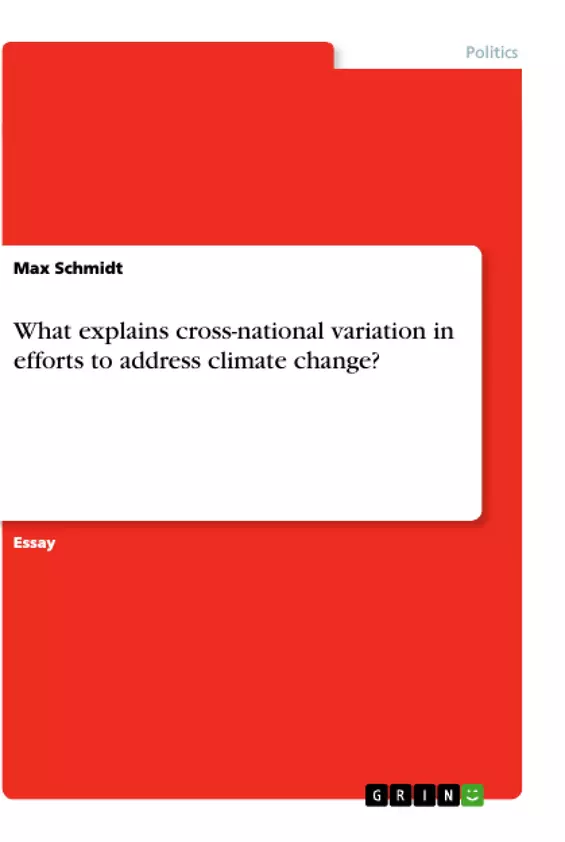This essay will analyse one possible cause for addressing climate change with varying efforts that is often neglected in the climate policy literature: countries’ vulnerability to climate-related risks (e.g. floods, droughts, tropical storms). Under the most important factors that influence the degree to which a country is vulnerable are its geographical location and level of economic development. Hence, exacerbated by their dependency on especially vulnerable economic sectors such as agriculture, low-income countries face the biggest climate-related risks.
Generally, two ways of addressing climate change can be differentiated: adaptation and mitigation. While most of the adaptation literature to the minimization of climate-related risks is about strategies of developing countries, literature about their mitigation efforts – understood here as policy decisions to reduce greenhouse gas (GHG) emissions – is still rare. A similar picture can be drawn for emerging economies – countries that are not recognised as industrialised countries, despite the high growth rates of their Gross Domestic Product (GDP) and newly emerging middle classes. Thus, the question can be raised to what extent vulnerability is a reason for them to address climate change.
To explore this topic, I will firstly lay out a research design (Most Similar Systems) that enables us to compare the vulnerability and mitigation efforts of Brazil, India and South Africa. I will focus on these countries and their mitigation efforts since they are among the biggest emerging economies which are, in general, expected to be “by far the most important source of future emission growth” (Urpelainen and van de Graaf 2017: 6). Based on my findings in the subsequent analysis, it can be said that a country’s vulnerability to climate-related risks plays no significant role in mitigating GHG emissions and consequently addressing climate change. This main argument will be critically discussed in the conclusion and research gaps identified.
In this essay, the dependent variable will be the strength of mitigation efforts of Brazil, India and South Africa to reduce their GHG emissions. As one of the two components of climate policy, the strength of mitigation efforts can be understood as the “extent to which the statutory provisions of climate policies are likely to restrict GHG emissions if implemented as intended” (Compston and Bailey 2016: 145).
Inhaltsverzeichnis (Table of Contents)
- Introduction
- Research design
- Analysis
- Conclusion
Zielsetzung und Themenschwerpunkte (Objectives and Key Themes)
This essay aims to analyze the influence of a country's vulnerability to climate-related risks on its efforts to address climate change, particularly through mitigation efforts. The essay focuses on the case of Brazil, India, and South Africa, comparing their vulnerability levels and mitigation targets. It uses the "Most Similar Systems" research design to control for other factors.
- The role of vulnerability to climate-related risks in influencing mitigation efforts
- The comparison of mitigation efforts in Brazil, India, and South Africa as emerging economies
- The analysis of self-perceived vulnerability and climate risk indices to assess vulnerability levels
- The examination of Intended Nationally Determined Contributions (INDCs) as an indicator of mitigation efforts
- The exploration of the relationship between vulnerability, mitigation efforts, and economic development
Zusammenfassung der Kapitel (Chapter Summaries)
- Introduction: Introduces the research question and argues that countries' vulnerability to climate change is a significant factor in their efforts to mitigate GHG emissions. It highlights the importance of understanding mitigation efforts in emerging economies.
- Research design: Outlines the research design using the "Most Similar Systems" approach to compare Brazil, India, and South Africa. It defines the key variables and hypothesis to be tested.
- Analysis: Presents data on the three countries' self-perceived vulnerability and climate risk indices, highlighting India as the most vulnerable and Brazil as the least vulnerable. It then analyzes the countries' Intended Nationally Determined Contributions (INDCs), noting variations in mitigation targets despite differences in vulnerability.
Schlüsselwörter (Keywords)
Climate change, mitigation, vulnerability, emerging economies, Brazil, India, South Africa, Intended Nationally Determined Contributions (INDCs), Climate Risk Index, Most Similar Systems research design.
- Quote paper
- Max Schmidt (Author), 2018, What explains cross-national variation in efforts to address climate change?, Munich, GRIN Verlag, https://www.grin.com/document/502807



